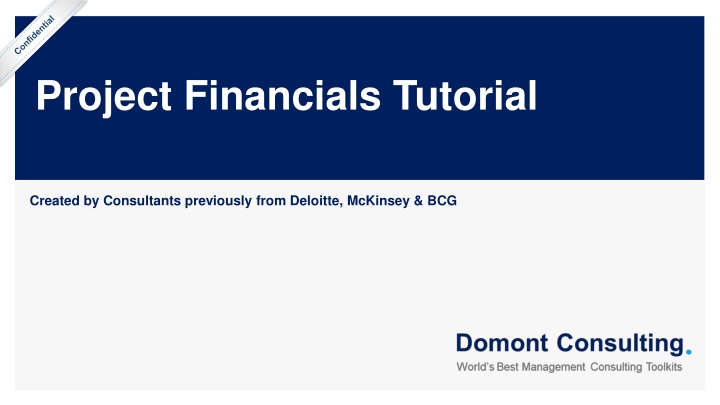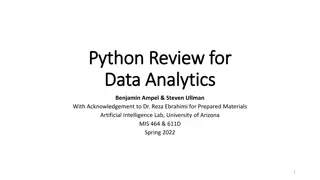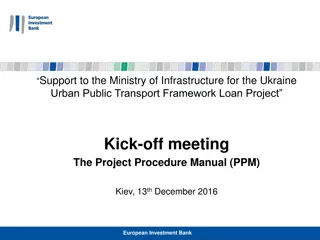
Guide to Project Financial Analysis: Key Concepts & Framework
"Learn about project financials including cash flow, NPV, payback period, IRR, and more through this comprehensive tutorial created by ex-consultants from top firms like Deloitte, McKinsey & BCG."
Uploaded on | 3 Views
Download Presentation

Please find below an Image/Link to download the presentation.
The content on the website is provided AS IS for your information and personal use only. It may not be sold, licensed, or shared on other websites without obtaining consent from the author. If you encounter any issues during the download, it is possible that the publisher has removed the file from their server.
You are allowed to download the files provided on this website for personal or commercial use, subject to the condition that they are used lawfully. All files are the property of their respective owners.
The content on the website is provided AS IS for your information and personal use only. It may not be sold, licensed, or shared on other websites without obtaining consent from the author.
E N D
Presentation Transcript
Project Financials Tutorial Created by Consultants previously from Deloitte, McKinsey & BCG
Table of Contents 1. Overview 2. Cash Flow 3. Cumulative Cash Flow 4. Net Present Value (NPV) 5. Payback Period 6. Internal Rate of Return (IRR) 7. Return on Investment (ROI) 2
Overview The Excel document Financial Model includes 1 inputs sheet, 5 calculation sheets and 2 Outputs sheets Inputs sheet Calculation sheets Outputs sheets Project Initial Investment Project Costs Additional Revenue Generated Project Financials Summary Assumptions Project Cash Flow Chart Cost Savings WACC 3
Timeframe Description The most common timeframe to estimate the financial performance of a project is 5 years. Year 0 is the present day. Year 1 represents the first 12 months. Year 2 represents the period between 12 months and 24 months, etc. 4
Project Initial Investment Description The Project Initial Investment represents the amount that you invest at the beginning of a project. It is usually a one-off cost that you need to input in Year 0. 5
Project Costs Description The Project Costs represent the ongoing amount of money that you will be spending each year. It includes the labour cost required to implement the project. 6
Additional Revenue Generated Description The Additional Revenue Generated represents the incremental revenue that the company will make due to the project. For example, you may estimate that the creation of a new product feature will increase your sales by 4%. 7
Costs Savings Description Cost Savings represents the cost that the company will save due to the project. For example, if you replace an expensive material with a cheaper material to manufacture your products, you may decrease the cost of your products by 10%. 8
Cash Flow Description Cash Flow represents the amount of cash that will be generated due to the project. The formula to calculate your Project Cash Flow is: Additional Revenue Generated + Cost Savings - Project Costs - Project Initial Investment. The Project Cash Flow will usually be negative in the first years and then become positive. If you estimate that it will never become positive, then you may decide to invest your money in a better performing project. 9
Cumulative Cash Flow Description Cumulative Cash Flow represents the total amount of cash that will be generated since the beginning of the project. The formula to calculate your Cumulative Cash Flow for, let s say, Year 2 is: Cash Flow in Year 0 + Cash Flow in Year 1 + Cash Flow in Year 2 10
Net Present Value Description A Net Present Value (NPV) analysis will help you estimate the net present value of future cash flows that you will receive over a period of time. Because money today could be earning interest, a dollar received now is worth more than a dollar received in the future. As a result, future cash flows should be discounted. 11
Net Present Value Description Here is the formula: 1 NPV for year 1 = Year 1 Cash Flow X (1+ Growth rate)Period Year 1 is period #1, Year 2 is period #2, etc. 12
Discount Rate Description Because money today could be earning interest, a dollar received now is worth more than a dollar received in the future. To reflect this principle, a discount rate is used to discount future net cash flows to present value. A company usually has a standard assumed discount rate provided by the Finance department This discount rate is often calculated based on the Weighted Average Cost of Capital (WACC), that is to say the cost of receiving money from your bank and shareholders In our example, the company has a discount rate R of 9% 13
Weighted Average Cost of Capital (WACC) Excel document automatically calculating WACC 14
Weighted Average Cost of Capital (WACC) Description Weighted average cost of capital (WACC) represents a firm s cost of capital from all sources, including common stock, preferred stock, bonds, and other forms of debt. In other words, WACC measures a company s cost to borrow money. The WACC formula uses both the company s debt and equity in its calculation. And each source of capital is proportionally weighted. WACC is often the discount rate that a company uses to estimate its net present value of its future cash flow. WACC formula and calculation: = + WACC E/V x Re D/V x Rd x (1-Tc) Where: E=Market value of the firm s equity D=Market value of the firm s debt V=E+D Re=Cost of equity Rd=Cost of debt Tc=Corporate tax rate 15
Period Description In order to calculate your Net Present Value, you will also have to use the Periods. Year 1 is period 1, Year 2 is period 2, etc. 16
Payback Period Description The Payback Period is the amount of time (usually measured in years) it takes to recover the project investment. In other words, it is the breakeven point. In our example, it is easy to see that we needed more than 3 years to break even . To know exactly how much longer, we need to create 3 rows that will help us calculate the exact breakeven point. 17
The 3 required rows to calculate payback period Description To calculate the payback period, you need to create: 1. A row to calculate the number of years of negative cumulative cash flow 2. A row to calculate the fraction for each year that does not have a negative cumulative cash flow 3. A row that will identify the relevant fraction that will be added to the number for the negative cumulative cash flow. In our example, the fraction that we need is the one for Year 4. 18
Payback Period Description The payback period will simply be your number of negative cumulative cash flow + the fraction of the first year of positive cash flow. 19
Internal Rate of Return (IRR) Description IRR is the rate of growth a project is expected to generate. To calculate IRR, you simply need to: 1. Use the IRR Excel formula by inputting =IRR( in the relevant cell 2. Select your cash flow from year 0 to year 5 3. Close the bracket ) 20
Return on Investment (ROI) Description ROI is simply calculated with the formula below: How much money you ve made divided by how much money you ve spent 21
Interested in more than 1 Toolkit? Access all our Toolkits for half the price with our Gold Access Gold Access Click here to learn more Click here to learn more 22
Thanks for your attention! www.domontconsulting.com 23






















